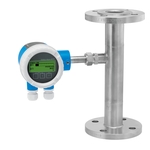Many people are made uncomfortably cold by just a small draft. The thermal flow measuring principle is based on the fact that heat is drawn from a heated body when a fluid flows past.
A thermal flowmeter contains two PT100 temperature sensors for this purpose. One sensor measures the current fluid temperature as a reference. The second sensor is heated and has a constant temperature differential relative to the first sensor at “zero flow.” As soon as the fluid begins to flow in the measuring tube, the heated temperature sensor cools off due to the fluid flowing past – the higher the flow velocity, the greater the cooling effect. The electric current required to maintain the temperature differential is thus a direct measure of mass flow.
Watch the video to learn how the thermal flow measuring principle works and read more about it here!
Advantages of thermal flowmeters at a glance
- Multivariable – direct measurement and display of mass flow and fluid temperature
- No pressure or temperature compensation required
- High turndown (max. up to 1000:1)
- Excellent low-end sensitivity
- Quick reaction to fluctuations in flow
- Negligible pressure loss
- Maintenance-free, no moving parts
Video Transcript
The most diverse gases are transported and distributed in piping systems every single day. They can include air in the water and waste water industry, carbon dioxide in food and beverages, nitrogen and oxygen in pharmaceuticals or natural gas for boilers and burners.
The gases flowing through pipes often have different properties caused by changing process conditions. Therefore, different operating principles are required for their measurement. One principle is flow measurement based on the thermal principle.
The basic physics of this principle can be traced back to the Canadian physicist Louis Vessot King. In 1914, he mathematically described heat transport in flows.
Here is how this measurement method works.
Inside thermal flowmeters are two temperature sensors protruding into the measuring tube. They are known as Pt100 resistance thermometers.
One of these temperature sensors measures the actual gas temperature as a reference – regardless of the flow velocity.
The second temperature sensor is heated constantly via electrical energy, so that a pre-defined temperature difference is maintained between the two sensors – for example, 10 degrees.
If there is no flow, the differential temperature between the two sensors does not change.
As soon as the fluid begins to flow in the measuring tube, heat is drawn from the heated temperature sensor via the gas flowing past. The heat then is carried off by the flow.
The corresponding cooling effect is measured and compensated immediately by adding more heating current. As a result, the target temperature difference is continuously maintained.
The heating current required to maintain the temperature difference is proportional to the cooling effect and therefore is a direct measure for the mass flow in the pipe.
The greater the flow velocity – and therefore the additional cooling of the heater sensor – the greater the heating current required.
An alternative adaption of the principle keeps the heater current at a constant value and then meausures the change in temperature differential.
But how is the heat actually transferred from the heated temperature sensor to the gas flowing past?
This sequence shows that the heat is transferred by the gas molecules themselves. When the gas flows past, the molecules absorb tiny heat packets and carry them along with the flow. The faster the gas flows, the more often they absorb the heat.
The heat transfer also depends on the density of the gas because at a higher pressure – or a lower temperature – there are more gas molecules in the pipeline. The greater number of molecules results in more contact with the heated sensor, meaning increased cooling and thus increased heating current flow.
And finally, the heat transfer is also affected by the thermal properties of the gas. For example at the same mass flow, the high thermal conductivity of hydrogen – shown here in green – causes cooling that is 100 times greater than with air. For a precise measurement, it’s therefore important that the specific properties of the gas are known and are consistent.
Flow measurement using the thermal principle is also possible in large pipes and ducts. There are meter types, designed specially for this application. They can be inserted directly into the pipe via a standard process connection. It is important that the required insertion depth be respected so that the measurement is carried out at the correct point.
For that reason it is essential to programme the actual internal pipe diameter for all insertion meters. Correct insertion also applies for rectangular and square ducting often found in factory or building air circulation systems.
With thermal mass flowmeters from Endress+Hauser many different gases and gas mixtures can be accurately measured – even at low process pressures and low flow velocities.
For all applications, we have the right solution.
Endress+Hauser – your single-source supplier for measurement technology!

%20Insertion%20version%20-%20PP01.jpg)

%20Insertion%20version%20-%20PP01.jpg)

%20with%20flange%20connection%20-%20PP01.jpg)
%20Inline%20version%20with%20flange%20connection%20(remote%20version)%20-%20PP01.jpg)








